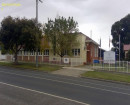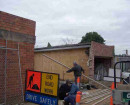BRIGHT CANYON
POREPUNKAH ROAD BRIGHT, ALPINE SHIRE
-
Add to tour
You must log in to do that.
-
Share
-
Shortlist place
You must log in to do that.
- Download report




Statement of Significance
What is significant?
The Canyon Hydraulic Gold Sluicing Site consists of a large excavation containing a network of pebble dumps and tail races. The tail races have been cut through a ridge of bedrock from the open pit to the River Ovens. Water for sluicing would have been delivered to the site by water races and then directed at the gold bearing deposits. The technology was introduced into Victoria in about 1855. The main period for hydraulic sluicing on the Ovens at Bright was during the 1870s-80s.
How is it significant?
The Canyon Hydraulic Gold Sluicing Site is of historical, archaeological and scientific importance to the State of Victoria.
Why is it significant?
The Canyon Hydraulic Gold Sluicing Site is historically and scientifically important as a characteristic and well preserved example of an early form of gold mining. Gold mining sites are of crucial importance for the pivotal role they have played since 1851 in the development of Victoria. Hydraulic sluicing of alluvial gold deposits is an important key ingredient in an understanding of gold mining technology as it was employed in country where water was plentiful and perennial.
The Canyon Hydraulic Gold Sluicing Site is archaeologically important for its potential to yield artefacts and evidence which will be able to provide significant information about the cultural history of gold mining and the gold seekers themselves.
[Source: Victorian Heritage Register]
-
-
BRIGHT CANYON - History
Heritage Inventory History of Site:
Sluicing was conducted on an extensive scale at Bright from 1856, with large claims worked by hydraulic sluicing from the early 1870s. 'The Canyon' appears to be a comparatively modern name for the carved-out landscape created by sluicing operations.
References:
Lloyd & Nunn, p. 14
Mining Surveyors' Reports (Buckland Division), July 1861, September 1873, September 1876Heritage Inventory Description
BRIGHT CANYON - Heritage Inventory Description
Area of bank of Ovens River, W of Bright, heavily worked for alluvial gold. At least 20 water races, some cut metres deep through rock. (Story)/nThe Canyon is a massive sluiced open cut extending along the western side of the Ovens River. The open cut is very overgrown with fir and blackberries but has a continuous covering of pebble wash. Through the pebble dumps run several tailraces which drain into the river. The tailraces have been cut through a ridge of bedrock from the open cut to the river: the deepest is 14 ft. A walking track (the Canyon Walk) follows the western bank of the river, crossing at least 12 tailraces, some by small bridges. Towards the northern end of the workings, the alluvial ground was shallower and the pebble dumps and tailraces extend to the river, the track rising and falling like waves on the sea. (Bannear)
Heritage Inventory Significance: Regional The site has: Historical significance - Relatively undisturbed but very overgrown sluicing landscape Scientific significance - with numerous tail races, developed walking track, Landscape values - evocative location on Ovens River.
-
-
-
-
-
THE CANYON HYDRAULIC GOLD SLUICING SITE
 Victorian Heritage Register H1231
Victorian Heritage Register H1231 -
BRIGHT CANYON
 Victorian Heritage Inventory
Victorian Heritage Inventory -
STAR BRIDGE
 Victorian Heritage Inventory
Victorian Heritage Inventory
-
-









